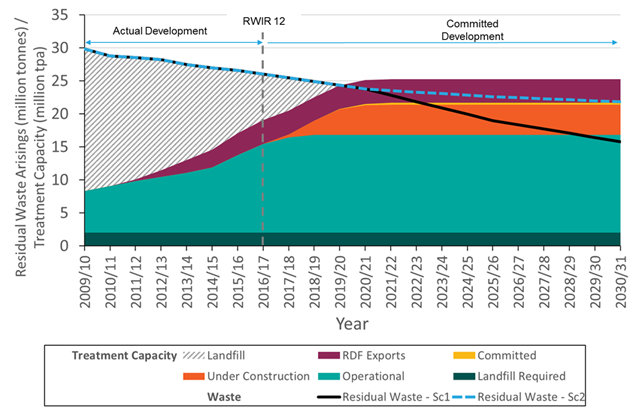
Research firm Eunomia has reaffirmed the findings of its 12th Issue Residual Waste Infrastructure Review (RWIR), which found that the UK is heading towards an overcapacity of waste plants.
The Bristol-based consultancy has responded to criticism of its report and ‘backed up’ its RWIR with ‘straightforward’ figures.
Chart shows Eunomia’s forecasts for residual waste decline: black line, scenario one; and blue-dash line, scenario two Eunomia claimed: “Even without the sophisticated modelling of the RWIR, published figures undermine the view that the UK will have a shortfall in treatment capacity in 2030, as has been suggested in response to our report.”
Report
In its report published last week (7 August), Eunomia claimed to show that the UK is heading “inexorably” towards the point where there will be more energy from waste and other residual waste treatment plants than needed.
And, it suggested that because of this, the UK recycling rate will be pegged back to a maximum of 63%. (see letsrecycle.com story)
However, the findings of the report were criticised by the Environmental Services Association (ESA), which dismissed the report as ‘flawed’.
In response, ESA’s executive director Jacob Hayler said that ‘year after year’ consultants had claimed that the UK was heading for overcapacity.
Mr Hayler said there was a consensus that the UK will be short of capacity. “The consensus position on waste treatment is that we will end up over five million tonnes short of energy from waste capacity by 2030. This is what the government needs to understand if it is not to sleepwalk into a capacity crisis.”
However, as yet, the ESA has not released figures to explain the energy from waste shortage.
Expanding on its original report, Eunomia explained that the UK landfilled around 11 million tonnes of waste at the standard rate of landfill tax last year, of which ‘probably no more than 9 million tonnes’ would be suitable or available for treatment by incineration.
Facilities
Eunomia said there are 4.8 million tonnes per annum (tpa) of facilities under construction or financially committed. And, to move from the current 44.3% recycling rate to the 50% municipal waste recycling target, to which the UK is already committed, means reducing residual waste by around 1.5 million tpa.
The consultancy continued: “By 2020, the capacity gap closes to 2.7 million tonnes, even before accounting for the likely continuation of the long term decline in commercial and industrial residual waste.“
“If waste does not start to grow, and if municipal waste recycling rates increase to 70%, then residual waste will fall by 7 million tpa.”
“With no facilities other than those already in construction, the UK would have around 2.8 million tpa more treatment capacity than residual waste for treatment: the excess in 2030 would be of the order 2.8 million tonnes – again, leaving aside any improvement in recycling from the C&I sector.”
Targets
Eunomia said this does not mean that there is no case for a given developer to build a new facility, as some developers may take the view that they can out-compete existing facilities.
However, the consultancy warned, that for waste outside local authority contracts, and which is not subject to specific recycling targets, the likely competition for waste may lead to business failures, and declining gate fees for residual waste, ‘eroding the business case for recycling.’
Eunomia chairman, Dr Dominic Hogg, added: “The exact date when UK treatment capacity will exceed the available waste is debatable, but the ultimate destination is clear.”
To avert the problem, he called urgently for ambitious targets and policies that demonstrate the UK’s intention to reduce substantially the amount of residual waste generated in future.

